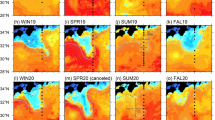Summary
The changes of relative topographies also represent the changes of atmospheric energies that are not compensated, and therefore contribute to development (cyclogenesis, strengthening of fronts, etc.). The interdiurnal changes of thicknesses were evaluated for four seasons (2 summers and 2 winters) for four Alaskan upper air stations (Anchorage, Fairbanks, Nome, Barrow) and for one station in the Bering Sea (St. Paul Isl.).
The following correlations were computed: between thicknesses and thickness changes, simultaneous and with lag of 24 hours, between 24hourly thickness and surface pressure changes — simultaneous and with lag of 24 hours, between simultaneous interdiurnal thickness changes at two neighboring stations.
Results: The correlations between thicknesses are very good, especially for adjacent layers. Also, the correlations between simultaneous thickness changes are generally good, but smaller than the correlations between thicknesses themselves. The correlations between thickness changes with lag of 24 hours are generally poor, and there is no preference betweenr (higher/lower) andr (lower/higher); however, the correlations between adjacent layers and more remote layers are of the same magnitude. The correlations between thickness changes and surface pressure changes, simultaneous changes and changes with lag of 24 hours, are generally poor, but the correlations between surface pressure changes andfollowing thickness changes are much better, which again raises the problem of “influencing” or “steering”. As expected, the correlations of simultaneous interdiurnal thickness changes between stations depend on the distance between the stations, and very likely also on the strength and extent of baric configuration.
The evaluation of a station outside Alaska (St. Paul Isl.) for two seasons did not contribute anything new. Further investigations are suggested.
Zusammenfassung
Die Änderungen der relativen Topographien repräsentieren auch die Änderungen der atmosphärischen Energien, die nicht kompensiert sind, und darum zu atmosphärischen Entwicklungen beitragen (Zyklogenese, Verstärkung der Fronten usw.). Die interdiurnen Änderungen der relativen Topographien wurden für vier Jahreszeiten (2 Sommer und 2 Winter), für vier Stationen in Alaska (An chorage, Fairbanks, Nome, Barrow) und für eine Station in der Bering-See (St. Paul Isl.) untersucht.
Folgende Korrelationen wurden berechnet: zwischen den Werten und den Dikkenänderungen der relativen Topographien bei gleichzeitigen Änderungen und bei Änderungen mit einer Verzögerung von 24 Stunden; zwischen gleichzeitigen interdiurnen Änderungen der relativen Topographien an zwei benachbarten Stationen.
Die Resultate zeigen: Es bestehen sehr hohe Korrelationen zwischen den relativen Topographien, besonders für anliegende Schichten. Auch die Korrelationen zwischen gleichzeitigen Änderungen der relativen Topographien sind im allgemeinen hoch, jedoch kleiner als die Korrelationen zwischen den relativen Topographien selbst. Die Korrelationen zwischen den 24stündigen Änderungen der relativen Topographien mit einer Verspätung von 24 Stunden sind schwach, und es besteht kein Unterschied zwischenr (niedrig/hoch) undr (hoch/niedrig). Die Korrelationen zwischen anliegenden und in vertikaler Richtung weiter entfernten Schichten sind aber von derselben Größenordnung. Die Korrelationen zwischen den Änderungen der relativen Topographien und den Änderungen des Luftdruckes am Boden für gleichzeitige Änderungen und für Änderungen des Luftdrucks am Boden nach 24 Stunden sind im allgemeinen schwach; die Korrelationen zwischen den Änderungen des Luftdruckes am Boden und dennachfolgenden Änderungen der relativen Topographien sind viel besser. Das wirft wieder die Frage nach der „Einwirkung” oder der „Steuerung” auf.
Wie zu erwarten war, sind die Korrelationen zwischen gleichzeitigen Änderungen der relativen Topographien an zwei Stationen von der Entfernung der Stationen abhängig und sehr wahrscheinlich auch von der jeweiligen Druckverteilung.
Die Auswertungen für eine Station außerhalb von Alaska (St. Paul Isl.) für zwei Jahreszeiten haben nichts neues gebracht.
Weitere Untersuchungen sind erwünscht.
Similar content being viewed by others
References
Haurwitz, B.: Dynamic Meteorology, pp. 138–141, 1941. Brunt, D.: Physical and Dynamical Meteorology, pp. 188–190, 1944. Zimmerschied, W.: Bearbeitung aerologischer Messungen. In: Linkes Meteorologisches Taschenbuch, Neue Ausgabe, II, hg. von F. Baur, pp. 366–367, 1953. Smithsonian Meteorological Tables, Washington, p. 224, 1958.
Putnins, P.: Über das Vorauseilen der Kaltluftmassen in der Höhe. Meteorol. Z.59, 218–224 (1942).
Scheibe, G.: Ageostrophische Strömungsverhältnisse im Bereich troposphärischer Starkwindfelder. Z. Meteor.22, 96–107 (1971).
Putnins, P., W. Schallertet al.: Some Aspects of the Meteorological Dynamics in the Greenland Area. Quart. Report, January 1 to March 31, 1959. Spons. U. S. Army Signal Res. and Develop. Laboratory, Fort Monmouth, New Jersey. Contract No. DA 3-99-04-112 under MIPR No. R-65-8-99831-SC-01-91. U. S. Weather Bureau, Washington, D. C., pp. 33–48, 1959.
Putnins, P., W. Schallertet al.: Some Meteorological and Climatological Problems of the Greenland Area. Final Report, June 20, 1958 to July 31, 1959. Spons. U. S. Army Signal Res. and Develop. Laboratory, Fort Monmouth, New Jersey, Contract No: DA 3-99-04-112 under MIPR No. R-65-8-99831-SC-01-91. U. S. Weather Bureau, Washington, D. C., pp. 129–141, 1959.
Putnins, P., V. J. Creasi, and H. Rosendal: Some Further Studies on the Meteorology of the Greenland Area. Final Report, Novemerb 1, 1960 to January 31, 1961. Spons. U. S. Army Signal Res. and Develop. Laboratory, Fort Monmouth, New Jersey. Contract No. DA 3-99-00-500 MIPR No. R-65-8-99831-SC-03-91. U. S. Weather Bureau, Washington, D. C., 1961, pp. 1–34.
Putnins, P.: Correlations between Pressure Changes Aloft and at the Surface in the Greenland Area, and Some Aspects of the “Steering” Problem. Arch. Met. Geoph. Biokl., A,13, 218–240 (1962).
Putnins, P.: The Propagation of Pressure Canges, and the Problems of the Contribution of the Troposphere and the Stratosphere to Surface Pressure Changes. In: “Studies on the Meteorology of Greenland, Second Interim Report, June 15, 1962 to March 15, 1963. Spons, the U. S. Army Electronics Material Agency, Fort Monmouth, New Jersey, Department of the Army Project No. 3-A-99-27-005 under MIPR No. R-62-9-SC-00-91. U. S. Dept. Commerce, Weather Bureau, pp. 1–51.
Putnins, P.: Einige Probleme der atmosphärischen Zirkulation im Gebiete Grönlands. Meteorol. Rundschau18, 76–77 (1965).
Scherhag, R.: Neue Methoden der Wetteranalyse und Wetterprognose, pp. 227–229. Berlin-Göttingen-Heidelberg: Springer-Verlag, 1948.
Author information
Authors and Affiliations
Additional information
With 1 Figure
Rights and permissions
About this article
Cite this article
Putnins, P. The correlations beetween the changes of atmospheric energies over Alaska as manifested by the changes of relative topographies. Arch. Met. Geoph. Biokl. A. 22, 11–32 (1973). https://doi.org/10.1007/BF02247671
Received:
Issue Date:
DOI: https://doi.org/10.1007/BF02247671




